Liliums
BackLiliums, or lilies, are adored by gardeners and flower arrangers as their beautiful blooms come in many colours and last well in the vase. Some even come with a heady perfume. There are also many different types to grow with there being around 100 lilium species and countless varieties thanks to having been cultivated for thousands of years.
It’s worth pointing out that while there are lots of plants commonly called lilies, from a botanical perspective, it is the lilium which is the only true lily – all the others are imposters!
How to Grow Liliums
Liliums can be grown Australia wide and almost all will tolerate frosts. Most do best when planted in full sun but in very hot areas give them morning sun and some afternoon shade. Plant into rich, fertile soils that drain freely as bulbs will rot in heavy clay. Poor soils should be improved with compost and manure before planting. Ensure the position is protected from strong winds that can damage the flower stem.
Liliums are usually purchased as dormant bulbs in winter or early spring and should be planted immediately as the bulb is vulnerable to drying out. Be sure to plant the bulbs deeply (10cm or more) as the bulb likes to stay cool. Water in with OCP eco-seaweed and cover with mulch. Potted plants that are close to flowering can also be purchased from florists and nurseries.
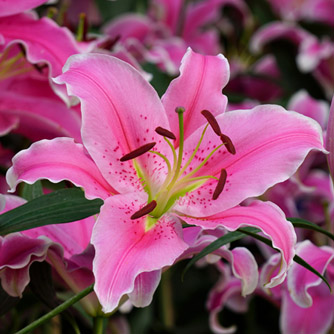
Stunning pink oriental lily
For good growth and flowering lilies must be kept moist during their growing cycle. So that means regular watering from spring into autumn until they die down.
If growing them in pots always use a premium quality potting mix. Choose a pot at least 20cm wide for one bulb or bigger again if you want to plant a group of bulbs. If growing a tall variety and there’s a chance of wind damage then insert a central stake to provide support. Water newly planted bulbs with OCP eco-seaweed.
Safety Warning
Note that lilium flowers are toxic if eaten by cats and the pollen can stain clothing and furniture. If picking flowers for indoors remove the anthers as soon as the bloom open.
Fertilising and Maintaining Liliums
As these are plants which originate from rich soils they really do perform best when given fortnightly doses of OCP eco-seaweed and OCP eco-aminogro right through their growing season (spring to autumn). You’ll be rewarded with much better flowering.
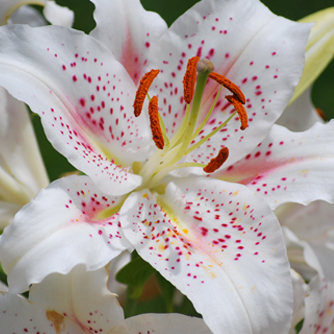
The elegant white oriental lily
In autumn plants will start to yellow and once the foliage has died off completely the stems should be cut down to ground level. Bulbs can be left in the ground to naturalise for several years but if you want to divide or transplant them then now is the time to do it. Take the opportunity to work in compost and manure before replanting to further enrich your soil.
Refresh potted liliums every couple of years with new potting mix to ensure the drainage remains good.
Propagating Liliums
Liliums can be easily propagated using these methods:
- If grown well the main bulb will develop small, baby bulbs. Remove and replant 2-3cm deep into a container filled with potting mix and water in with OCP eco-seaweed. When new plants form they can be potted up or planted in the garden.
- Some liliums will product bulbils between the stem and leaves about the size of a marble. In autumn twist off the bulbils and plant into the soil or a pot.
- If you’re feeling brave you can break apart the main bulb by twisting off the fleshy scales and each scale will produce a new plant. Place the separated scales into a zip-lock plastic bag with some moistened sphagnum or peat moss. Shake the bag so the scales are covered and leave for a couple of months until baby bulbs form.
Note that the baby bulbs, bulbils and scales must not dry out otherwise they’ll fail. Keep an eye on them and give more water as required. It will take a few years for your new plants to reach flowering size.
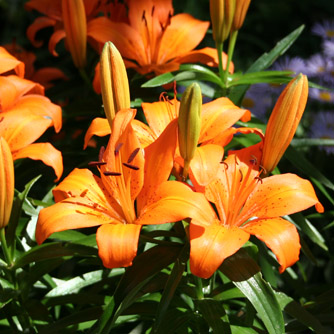
Vibrant orange Asiatic lilies
Pests & Diseases of Liliums
Lilies are generally pest free but can suffer from the following:
- Aphids – watch out for clusters of these sap suckers on new growth. Spray with OCP eco-oil as required.
- Snails & slugs – these pests love the new lily shoots as they appear in spring. Scatter OCP eco-shield pellets around the plants to protect the growth.
- Root rot – bulbs will easily rot away when grown in poorly draining soils. If you have heavy soils then work in plenty of organic matter (compost and manures) as well as some gypsum to help improve drainage. Alternatively plant bulbs into pots.
Lilium Varieties
As mentioned at the beginning there are many species and countless cultivars available. Below is a list of the key groups and a few of our favourites as well:
- Oriental hybrids: The absolute stars of the lily world with large, heavily perfumed flowers in shades of white, pink and yellow. Some are spotted and striped and some even have wavy petals. Double forms are also available. Ranging in height from 70cm-1.3m.
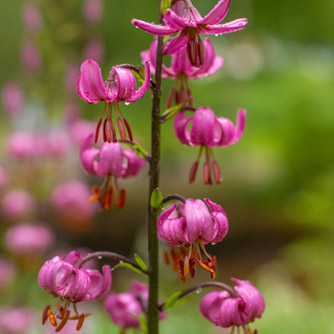
The distinctive Turk's cap lily
- Asiatic hybrids: Slightly less glamorous than orientals, and lacking in perfuming, these lilies make up for it by being easier to grow and coming in a broader range of colours. Double asiatic lilies, which are pollen free, are also sold. 30cm-1.2m tall.
- Christmas Lily (Lilium longiflorum): Flowers around Christmas time with long white scented flowers that have a light green throat. Also known as November lily and Easter lily (a nod to its northern hemisphere origins). Grows 90cm-1m tall.
- LA Lilies: A hybrid of L. longiflorum and Asiatic types, with lightly-scented flowers that are great in a vase. Expect 4-5 blooms per stem. 70cm-1.7m tall.
- Madonna lily (Lilium candidum): This lily is native to the Mediterranean and prefers alkaline soil (so add some lime around it). Tall stems have up to 20 white, fragrant flowers per stem in summer. 90cm-2m tall.
- Tiger Lily (Lilium lancifolium): Produces dramatic orange flowers with dark spots on the petals explaining its common name. There are also yellow and red varieties available. Plants product bulbils along the stem making it easy to develop a nice clump. Tolerant of poorer quality soils. Grows 80cm-1.5m.
- Turk’s Cap (Lilium martagon): These liliums have cute nodding flowers with petals that curve right back. If grown well they produce up to 50 fragrant flowers per stem and flowers are often spotted. Does best in dappled shade 90cm-2.4m tall.
- Regal Lily (Lilium regale): From China it has flared white trumpet flowers with yellow centres and purple flushes on the outside. Can product 20-30 fragrant flowers per stem. Sometimes called the Christmas lily. 1.5-2m tall.
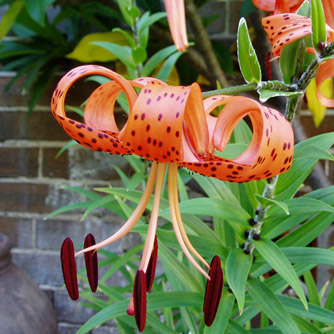
The spotted tiger lily with bulbils forming along the stem
Weed Warning: Avoid the Taiwan lily (Lilium formosanum) which is a weed in most of eastern Australia. It has long, white, trumpet flowers with pink-purple markings on the outside similar to the regal lily (Lilium regale) but the centre is white not yellow.
If you live near bushland then also be careful when growing tiger lilies (Lilium lancifolium) as they have the potential to become a weed thanks to the many bulbils they produce.
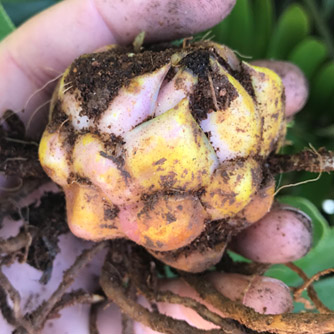
Lilium bulbs are made up of overlapping scales


